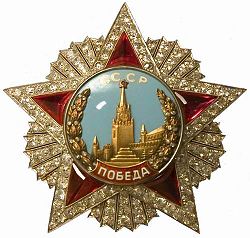Order of Victory
| Order of Victory | |
|---|---|

The Order of Victory
|
|
| Awarded by the |
|
| Type | Single-grade order |
| Eligibility | Military Generals and Marshals only |
| Awarded for | Conducting combat operations involving one or more army groups and resulting in a "successful operation within the framework of one or several fronts resulting in a radical change of the situation in favor of the Red Army" |
| Status | No longer awarded |
| Statistics | |
| Established | November 8, 1943 |
| First awarded | April 10, 1944 |
| Last awarded | February 20, 1978 (was revoked) |
| Total awarded | 20 |
|
Ribbon of the Order of Victory |
|
The Order of Victory (Russian: Орден "Победa", Orden "Pobeda") was the highest military decoration awarded for World War II service in the Soviet Union, and one of the rarest orders in the world. The order was awarded only to Generals and Marshals for successfully conducting combat operations involving one or more army groups and resulting in a "successful operation within the framework of one or several fronts resulting in a radical change of the situation in favor of the Red Army." In its history, it has been awarded twenty times to twelve Soviet leaders and five foreign leaders, with one revocation. King Michael of Romania is the last living recipient.
The order was proposed by Colonel N. S. Neyelov, who was serving at the Soviet Army Rear headquarters around June 1943. The original name that Colonel Neyelov suggested was Order for Faithfulness to the Homeland; however, it was given its present name around October of that year.
On the 25th of October 1943, artist A. I. Kuznetsov, who was already the designer of many Soviet orders, presented his first sketch to Stalin. The sketch of a round medallion with portraits of Lenin and Stalin was not approved by the Supreme Commander. Instead, Stalin wanted a design with the Spasskaya Tower in the centre. Kuznetsov returned four days later with several new sketches, of which Stalin chose one entitled "Victory". He asked Kuznetsov to slightly alter the design, and on the 5th of November a prototype was finally approved. The order was officially adopted on the 8th of November 1943, and was first awarded to Georgy Zhukov (#1), Alexandr Vasilevsky (#2), and Joseph Stalin (#3).
The order was also bestowed to top commanders of the Allied forces. Every order was presented during World War II, except for the controversial 1978 award to Leonid Brezhnev. Brezhnev's award was revoked posthumously in 1989 for not meeting the requirements for the award.
Like other orders awarded by Communist nations, the Order of Victory could be awarded more than once to the same individual. In total, the order was presented twenty times to seventeen people (including Brezhnev).
...
Wikipedia
